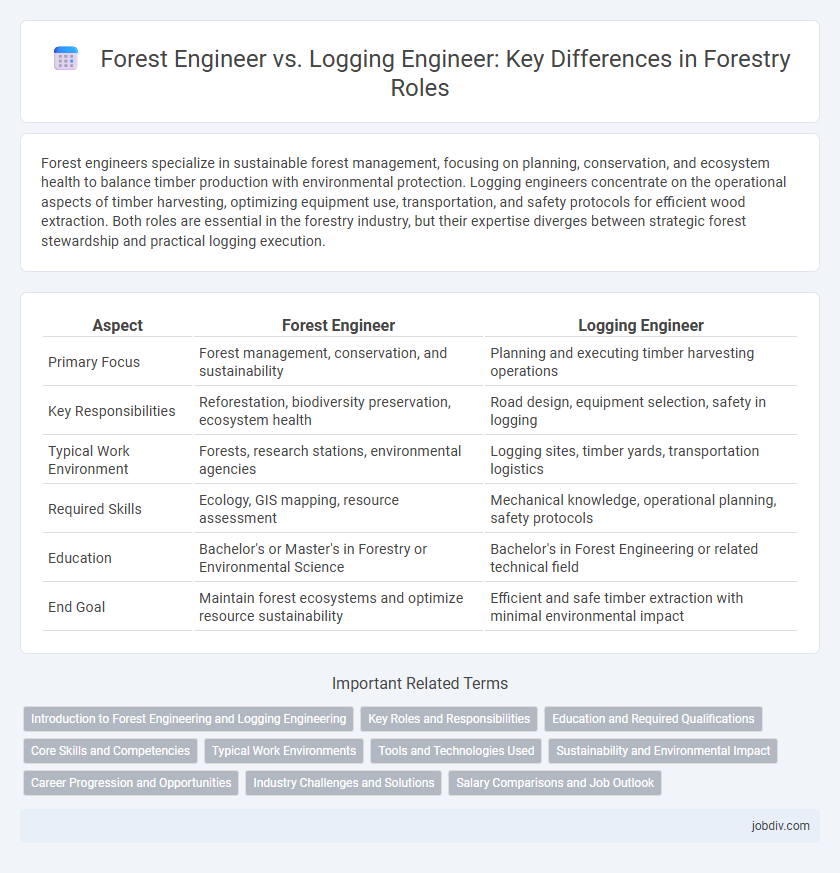Forest engineers specialize in sustainable forest management, focusing on planning, conservation, and ecosystem health to balance timber production with environmental protection. Logging engineers concentrate on the operational aspects of timber harvesting, optimizing equipment use, transportation, and safety protocols for efficient wood extraction. Both roles are essential in the forestry industry, but their expertise diverges between strategic forest stewardship and practical logging execution.
Table of Comparison
| Aspect | Forest Engineer | Logging Engineer |
|---|---|---|
| Primary Focus | Forest management, conservation, and sustainability | Planning and executing timber harvesting operations |
| Key Responsibilities | Reforestation, biodiversity preservation, ecosystem health | Road design, equipment selection, safety in logging |
| Typical Work Environment | Forests, research stations, environmental agencies | Logging sites, timber yards, transportation logistics |
| Required Skills | Ecology, GIS mapping, resource assessment | Mechanical knowledge, operational planning, safety protocols |
| Education | Bachelor's or Master's in Forestry or Environmental Science | Bachelor's in Forest Engineering or related technical field |
| End Goal | Maintain forest ecosystems and optimize resource sustainability | Efficient and safe timber extraction with minimal environmental impact |
Introduction to Forest Engineering and Logging Engineering
Forest engineering focuses on the sustainable management and conservation of forest resources through planning, designing, and implementing infrastructure such as roads, bridges, and erosion control systems to minimize environmental impact. Logging engineering specializes in the technical aspects of timber harvesting, optimizing machinery use, and improving extraction techniques to enhance productivity and safety during logging operations. Both disciplines integrate principles of ecology, soil science, and mechanical engineering to support efficient forest resource utilization.
Key Roles and Responsibilities
Forest engineers specialize in sustainable forest management, planning road construction, designing erosion control measures, and overseeing reforestation projects to maintain ecological balance. Logging engineers focus on optimizing timber harvesting operations, developing efficient cutting methods, managing equipment logistics, and ensuring worker safety during felling and transportation. Both roles require expertise in environmental regulations, but forest engineers emphasize conservation, while logging engineers prioritize productivity and operational efficiency.
Education and Required Qualifications
Forest Engineers typically hold a Bachelor's degree in Forestry, Natural Resources, or Environmental Science, with coursework emphasizing ecosystem management, soil science, and forest ecology. Logging Engineers require a similar academic background but often pursue specialized training or certifications in timber harvesting techniques, machinery operation, and safety regulations. Both professions demand strong knowledge of sustainable practices, but Logging Engineers focus more on the technical and operational aspects of timber extraction.
Core Skills and Competencies
Forest engineers specialize in ecosystem management, land surveying, and sustainable resource planning to balance environmental conservation with timber production. Logging engineers focus on operational efficiency, safety protocols, and machinery optimization to manage timber extraction and transportation. Both professions require expertise in environmental regulations, soil science, and computer-aided design (CAD) software for project planning and execution.
Typical Work Environments
Forest engineers primarily work in natural forest settings, research stations, and environmental consulting firms, focusing on forest management, ecosystem conservation, and sustainable resource planning. Logging engineers operate mainly at logging sites, sawmills, and timber production facilities, overseeing the safe and efficient harvesting, transportation, and processing of timber. Both professions often require fieldwork but differ in their operational settings, with forest engineers more engaged in strategic planning and logging engineers in logistical execution.
Tools and Technologies Used
Forest engineers primarily utilize Geographic Information System (GIS) technology, remote sensing tools, and computer-aided design (CAD) software to plan sustainable forest management and conservation strategies. Logging engineers focus on heavy machinery such as harvesters, skidders, and yarders, along with planning software tailored for efficient timber extraction and transportation logistics. Both roles increasingly integrate drone surveillance and GPS technologies to enhance operational precision and environmental monitoring.
Sustainability and Environmental Impact
Forest engineers specialize in sustainable forest management by designing and implementing practices that balance timber production with ecosystem conservation, minimizing soil erosion and habitat disruption. Logging engineers focus on optimizing the operational aspects of timber harvesting, emphasizing efficient resource use and reducing environmental impact through advanced machinery and planning techniques. Both roles contribute to sustainability, but forest engineers typically engage more in long-term ecological stewardship whereas logging engineers prioritize sustainable extraction methods.
Career Progression and Opportunities
Forest Engineers typically oversee sustainable forest management, resource planning, and environmental impact assessments, offering career progression into roles such as forest management consultants, conservation specialists, and policy advisors. Logging Engineers focus on the operational aspects of timber harvesting, including machinery optimization and logistics, enabling advancement into positions like operations managers, logging supervisors, and health and safety coordinators. Both fields provide opportunities in government agencies, private forestry companies, and environmental organizations, but Forest Engineers often have broader prospects in strategic planning and regulatory sectors.
Industry Challenges and Solutions
Forest engineers face challenges such as sustainable resource management, erosion control, and habitat preservation, requiring expertise in ecological impact assessments and land restoration techniques. Logging engineers confront operational issues like optimizing timber extraction, reducing environmental damage, and enhancing safety, employing solutions like advanced machinery, precision mapping, and compliant harvesting methods. Both roles collaborate to develop integrated strategies that balance economic productivity with environmental stewardship in the forestry industry.
Salary Comparisons and Job Outlook
Forest engineers typically earn a median annual salary ranging from $60,000 to $85,000, while logging engineers generally have salaries between $50,000 and $75,000, reflecting differences in job scope and responsibilities. Employment opportunities for forest engineers are expected to grow by approximately 5% over the next decade due to increased demand for sustainable resource management, whereas logging engineers face a more stable or slightly declining job outlook due to mechanization and stricter environmental regulations. Both professions require specialized technical skills, but forest engineers benefit from broader career options in environmental consulting, forestry management, and conservation projects.
Forest Engineer vs Logging Engineer Infographic

 jobdiv.com
jobdiv.com